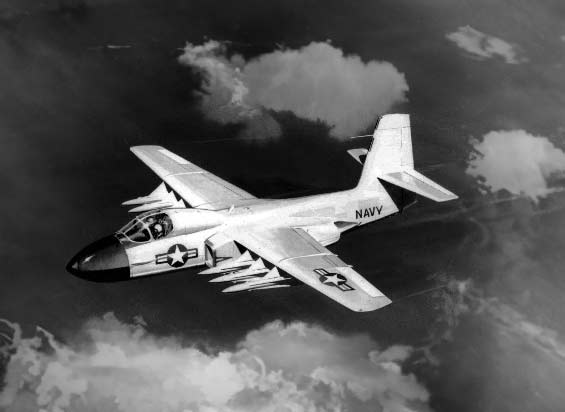The Douglas F6D Missileer was a Cold War-era carrier-based interceptor designed for long-range air-to-air missile engagement, never reached production.
In brief
The Douglas F6D Missileer was a proposed American carrier-based aircraft developed in the late 1950s for the U.S. Navy. Envisioned as a subsonic, long-endurance interceptor, it was designed to carry the then-new AAM-N-10 Eagle air-to-air missile. The Missileer featured a large wingspan for enhanced loiter capability, advanced radar systems for beyond-visual-range engagements, and was powered by two turbofan engines. Despite its innovative approach to fleet air defense, the program was cancelled in the early 1960s before any prototypes were built, due to shifts in defense priorities and questions about its effectiveness against rapidly advancing Soviet aircraft designs.
In the context of the Cold War era, the need for advanced naval air defense capabilities became paramount as the threat of Soviet bomber fleets armed with nuclear weapons grew. The U.S. Navy sought a dedicated interceptor that could engage enemy aircraft at long ranges, far before they could launch their payloads against carrier groups. This led to the development of the Douglas F6D Missileer, a program launched by the U.S. Navy in the late 1950s to meet these specific requirements. The Missileer was designed to counter high-speed, high-altitude threats by engaging them at distances over 100 miles away, leveraging new missile technology and radar systems. Despite never reaching production or flight status, the F6D Missileer program was a pivotal moment in naval aviation history, reflecting the evolving nature of aerial warfare and the strategic needs of the time.
Design
The design of the Douglas F6D Missileer was centered around its mission of long-range interception. With a wingspan of approximately 70 feet (about 21 meters) and powered by two Pratt & Whitney TF30 turbofan engines, the aircraft was optimized for endurance rather than speed, capable of loitering for extended periods to patrol vast areas of the ocean. Its most distinctive feature was the AN/ASG-18 radar, the most advanced airborne radar of its time, capable of detecting and tracking targets at unprecedented ranges. The aircraft was designed to carry six AAM-N-10 Eagle missiles, which were also in development alongside the Missileer. These missiles were intended to be the first operational long-range air-to-air missiles, allowing the Missileer to engage enemy bombers well before they could launch their own missiles or reach their target. However, the aircraft’s subsonic speed and large size made it vulnerable to faster, more maneuverable fighters, raising concerns about its survivability in contested airspace.

Performance
The Douglas F6D Missileer was designed to achieve a top speed of approximately 600 miles per hour (about 965 kilometers per hour) and had a projected service ceiling of around 40,000 feet (about 12,200 meters). Its range was one of its most impressive features, capable of conducting missions over 1,000 nautical miles (about 1,852 kilometers) away from its carrier. This performance enabled the Missileer to cover vast expanses of ocean, providing extended air defense coverage for carrier groups against potential aerial threats. However, compared to contemporary and later-developed aircraft like the F-4 Phantom II, which offered higher speed and versatility, the Missileer’s performance was seen as limited. Its specialized design for long-range missile engagement did not provide the flexibility required for the rapidly changing threat environment of the Cold War.
Variants
The Douglas F6D Missileer project was cancelled before any variants could be developed. The initial design and specifications remained the only version proposed. Following the cancellation of the Missileer program, the U.S. Navy shifted its focus to other aircraft and air defense systems that could fulfill multiple roles, including interception, air superiority, and ground attack.
Military Use and Combat
The Douglas F6D Missileer was never put into production or used in military operations, as the program was cancelled in the early stages of development. Therefore, it did not participate in any conflicts, nor was it sold to other countries. The cancellation stemmed from a reevaluation of the aircraft’s capabilities in the face of evolving threats and the realization that more versatile aircraft were needed to meet the broad range of challenges faced by the U.S. Navy. The conceptual legacy of the Missileer influenced the development of future air defense systems and the emphasis on beyond-visual-range combat capabilities in subsequent aircraft designs.
Although the Douglas F6D Missileer never advanced beyond the drawing board, its development marked a significant period in military aviation history, highlighting the strategic shift towards long-range, missile-based air defense systems during the Cold War. The focus on specialized aircraft for fleet defense influenced the evolution of naval aviation tactics and technology, paving the way for future innovations in airborne interception and air-to-air combat.
Back to the experimental aircraft section.